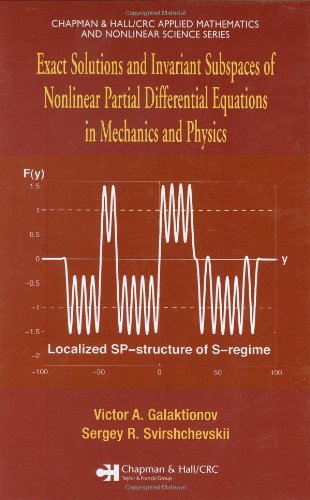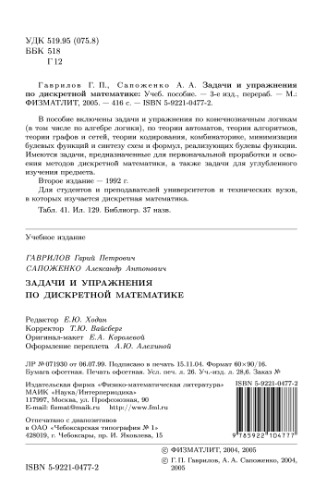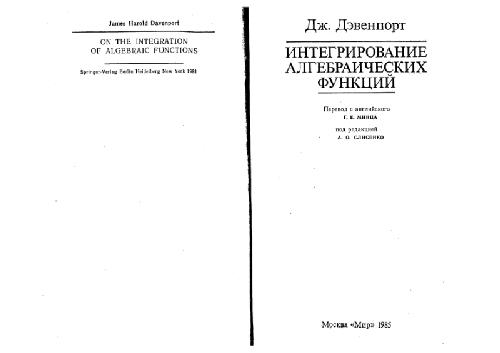Victor A. Galaktionov, Sergey R. Svirshchevskii1584886633, 9781584886631, 9781420011623
Table of contents :
Exact Solutions and Invariant Subspaces of Nonlinear Partial Differential Equations in Mechanics and Physics……Page 3
Contents……Page 6
References……Page 495
List of Frequently Used Abbreviations……Page 521
Exact solutions: history, classical symmetry methods, extensions……Page 9
Three-fold role of exact solutions: existence-uniqueness-asymptotics……Page 13
Linear invariant subspaces for nonlinear operators……Page 14
The heat equation and linear subspace for its fundamental solution……Page 15
The porous medium equation and linear subspace for its fundamental solution……Page 17
On nonlinear models and PDEs to be considered……Page 20
Main problems and targets……Page 21
Partial invariance as a manifestation of “partial integrability”……Page 22
Prerequisites: a GUIDE on models, nonlinear PDEs, and solutions……Page 27
Acknowledgements……Page 28
1.1.1 Five models from gas dynamics……Page 29
1.1.2 Nonlinear wave equation……Page 33
1.1.3 Quadratic Boussinesq-type equations……Page 34
1.1.4 Examples from reaction-diffusion-absorption theory……Page 35
1.2.1 Invariant subspaces……Page 44
1.2.3 Second extension: invariant subspaces for delay-PDEs……Page 45
1.2.4 Generalized separation of variables: first simple example……Page 46
1.3.1 Classification and first examples of polynomial subspaces……Page 48
1.3.2 General polynomial operators……Page 54
1.3.3 One-dimensional polynomial subspaces……Page 56
1.3.4 Operators of the same total order: criterion of invariance……Page 57
1.4.1 Some classification results and examples……Page 58
1.4.2 Non-local models from Navier–Stokes equations in IR2……Page 62
1.4.3 Criterion of invariance for polynomial operators……Page 64
1.5.1 Classification and examples……Page 65
1.5.2 General polynomial operators……Page 67
1.5.4 On subspaces of irrational functions: dipole-type solutions……Page 72
1.5.6 On reduction to quadratic equations……Page 73
Remarks and comments on the literature……Page 74
2.1 Main Theorem on invariant subspaces……Page 77
2.2 The optimal estimate on dimension of invariant subspaces……Page 82
2.3 First-order operators with subspaces of maximal dimension……Page 85
2.4 Second-order operators with subspaces of maximal dimension……Page 89
2.5.1 First-order operators……Page 95
2.5.2 Second-order operators……Page 97
2.6 Operators preserving polynomial subspaces……Page 100
2.6.1 Main Theorem for polynomial subspaces……Page 101
2.6.2 Operators of submaximal and lower orders……Page 102
2.6.3 Translation-invariant operators……Page 105
2.6.4 Translation-invariant quadratic operators……Page 107
2.7 Extensions to………Page 113
2.7.1 Main Theorem……Page 114
2.7.2 Theorem on the maximal dimension……Page 115
2.7.3 Examples……Page 116
2.7.4 Operators………Page 118
2.8 SUMMARY: Basic types of equations and solutions……Page 120
2.8.1 Invariant and partially invariant subspaces……Page 121
2.8.2 Invariant and partially invariant modules……Page 122
2.8.3 Further generalizations……Page 123
Open problems……Page 124
3.1.1 Typical quasilinear models from thin film theory……Page 125
3.1.2 Quadratic models: polynomial subspaces……Page 130
3.1.3 Cubic operators……Page 133
3.2.1 Invariant subspace and exact solutions……Page 134
3.2.2 Free-boundary setting……Page 135
3.2.3 Initial Dirac’s mass……Page 137
3.2.4 Extinction patterns……Page 138
3.2.5 On interface turning points……Page 139
3.2.6 Quenching patterns……Page 142
3.2.7 On extinction patterns with zero contact angle, the Cauchy problem……Page 143
3.2.8 Quartic operators: applications to extinction and blow-up……Page 144
3.3 Exact solutions with zero contact angle……Page 148
3.4 Extinction behavior for sixth-order thin film equations……Page 154
3.5.1 Blow-up and stability on W3 for fourth-order TFEs……Page 156
3.5.3 Partially invariant subspaces (modules) for quadratic operators……Page 160
3.6.1 Basic polynomial subspaces……Page 162
3.6.2 Solutions with zero contact angle conditions……Page 163
3.6.3 Extensions of polynomial subspaces……Page 164
3.6.4 Subspaces of irrational functions: dipole-type solutions……Page 166
3.7 Oscillatory, changing sign behavior in the Cauchy problem……Page 167
3.8 Invariant subspaces in Kuramoto-Sivashinsky type models……Page 176
3.9 Quasilinear pseudo-parabolic models: the magma equation……Page 184
Remarks and comments on the literature……Page 188
Open problems……Page 190
4.1 Blow-up and localization for KdV-type equations……Page 191
4.1.2 Applications to blow-up……Page 192
4.2.1 Compactons on 3D trigonometric subspace……Page 193
4.2.2 On shock and rarefaction waves in PDEs with nonlinear dispersion……Page 200
4.2.3 On interface equations for compactons……Page 203
4.2.4 On proper solutions by parabolic approximations……Page 204
4.2.5 Local behavior near interfaces for the K (2, 2) equation……Page 207
4.2.6 The signed K (2, 2) equation: TWs and oscillatory solutions……Page 209
4.3 Higher-order PDEs: interface equations and oscillatory solutions……Page 211
4.3.1 On the Cauchy problem……Page 212
4.3.3 5D trigonometric subspaces……Page 217
4.3.4 7D trigonometric subspace……Page 218
4.3.5 Cubic and higher-degree operators……Page 220
4.3.6 Exponential subspaces……Page 224
4.4.1 Preliminaries: Airy function, integral equation, and smooth solutions……Page 225
4.4.2 Finite propagation and oscillatory solutions……Page 228
4.5 On compactons in IRN for nonlinear dispersion equations……Page 232
4.6.1 Trigonometric subspaces……Page 238
4.6.2 Exponential subspaces: the FFCH equation……Page 241
4.6.3 Other related models……Page 243
4.7.1 PDEs and invariant subspaces……Page 248
4.7.2 On the maximal regularity, oscillatory behavior, and the Cauchy problem……Page 251
4.7.3 On the fundamental solution……Page 252
4.7.4 Oscillatory solutions of higher-order Harry Dym-type equations……Page 253
Remarks and comments on the literature……Page 254
Open problems……Page 262
5.1.1 Basic quasilinear wave models……Page 263
5.1.2 Stability of blow-up on invariant subspaces……Page 264
5.2 Breathers in quasilinear wave equations and blow-up models……Page 269
5.3.1 Basic singularity phenomena and stability……Page 280
5.3.2 Zero contact angle and oscillatory solutions……Page 284
5.3.3 Compactons in higher-order nonlinear dispersive Boussinesq equations……Page 286
5.3.4 On the modified Zabolotskaya–Khokhlov equation……Page 287
5.4.1 Main Theorem on invariant subspaces……Page 288
5.4.2 Examples: applications of the Main Theorem……Page 289
5.4.3 Invariant subspaces for quadratic systems……Page 291
5.4.5 On extensions of basic invariant subspaces……Page 296
Remarks and comments on the literature……Page 299
Open problems……Page 302
6.1.1 Basic polynomial subspaces……Page 303
6.1.2 Two quadratic water wave models……Page 306
6.1.3 Invariant subspaces driven by elliptic equations……Page 307
6.1.4 Models from transonic gas dynamics……Page 311
6.1.5 Maxwell equations in nonlinear optics……Page 313
6.2.1 Fourth-degree radial polynomial subspaces……Page 314
6.2.2 Logarithmic perturbation of quadratic polynomials……Page 316
6.2.4 Singular subspaces for the critical diffusion exponent……Page 319
6.2.5 On a cubic operator in IRN……Page 320
6.3 On the remarkable operator in IR2……Page 321
6.3.1 Polynomial subspaces……Page 323
6.3.2 The GSV and other invariant subspaces……Page 325
6.3.3 An application to systems……Page 326
6.3.4 On partial invariant modules……Page 327
6.4 On second-order p-Laplacian operators……Page 328
6.5.1 Second-order equations……Page 332
6.5.2 On higher-order Monge–Ampère-type equations……Page 340
6.6.1 Basic polynomial subspaces……Page 343
6.6.2 On solutions with zero contact angle at interfaces……Page 345
6.6.3 Blow-up and extinction for n = – 6 N+2……Page 348
6.6.4 On some extensions of polynomial subspaces……Page 351
6.6.5 On remarkable thin film operators in IR2……Page 352
6.7 Moving compact structures in nonlinear dispersion equations……Page 354
6.8 From invariant polynomial subspaces in IRN to invariant trigonometric subspaces in IRN–1……Page 355
6.8.1 Second-order operators……Page 356
6.8.2 Higher-order operators……Page 358
Remarks and comments on the literature……Page 359
Open problems……Page 364
7.1.1 Basic ideas and examples……Page 365
7.1.2 On further extensions……Page 371
7.2 Quadratic Kuramoto–Sivashinsky equations……Page 372
7.3.1 The general scheme for GSV……Page 374
7.3.2 The GSV in application: systems (I) and (II)……Page 376
7.4 Generalized separation and partially invariant modules……Page 377
7.4.1 Partially invariant 2D modules……Page 378
7.4.2 Existence of solutions via partial invariance……Page 379
7.4.3 On quasilinear hyperbolic PDEs for A………Page 383
7.4.4 On quadratic operators with linear properties……Page 387
7.4.5 On some other extensions……Page 389
7.5 Evolutionary invariant sets for higher-order equations……Page 390
7.5.1 Scaling order, index and evolutionary invariant sets……Page 391
7.5.2 Back to invariant subspaces: equivalent formulation……Page 393
7.5.3 Second-order parabolic PDEs……Page 395
7.5.4 Fourth-order generalized thin film equations……Page 396
7.5.5 Extensions……Page 397
7.5.6 Evolutionary invariant sets for hyperbolic PDEs……Page 400
7.6 A separation technique for the porous medium equation in IRN……Page 401
7.6.1 A separation problem……Page 402
7.6.2 Linear functions g(x, t)……Page 404
7.6.3 Quadratic functions g(x, t)……Page 407
Remarks and comments on the literature……Page 411
Open problems……Page 412
CHAPTER 8: Sign-Invariants for Second-Order Parabolic Equations and Exact Solutions……Page 413
8.1.1 On weak and proper solutions……Page 414
8.1.2 Maximum Principle and first examples of sign-invariants……Page 415
8.1.3 First-order sign-invariants……Page 416
8.2 Sign-invariants of the form………Page 417
8.2.1 Quasilinear heat equations and higher-order extensions……Page 418
8.3 Stationary sign-invariants of the form H(r, u, ur)……Page 422
8.3.1 Quasilinear heat equations……Page 423
8.4 Sign-invariants of the form………Page 429
8.4.1 Quasilinear heat equations……Page 430
8.4.2 Exact solutions……Page 431
8.5 General first-order Hamilton–Jacobi sign-invariants……Page 438
8.5.1 Proofs of main theorems……Page 439
8.5.2 P(v) is linear polynomial: exact solutions……Page 440
8.5.3 The linear critical case……Page 444
8.5.4 The degenerate case……Page 445
8.5.5 P(v) is a quadratic polynomial……Page 446
8.5.6 Interpretation via invariant subspaces and sets……Page 449
Remarks and comments on the literature……Page 451
9.1 Backward problem of invariant subspaces for discrete operators……Page 457
9.1.2 First integrals and operators for n = 2……Page 460
9.2 On the forward problem of invariant subspaces……Page 461
9.3 Invariant subspaces for finite-difference operators……Page 465
9.3.1 First examples……Page 467
9.3.2 N-dimensional quasilinear operators……Page 470
9.3.3 Five-dimensional invariant subspaces for N = 1……Page 472
9.3.4 Exact solutions on partially invariant subspaces……Page 475
9.4 Invariant properties of moving mesh operators and applications……Page 476
9.4.1 Introduction: MMMs and invariant subspaces……Page 477
9.4.2 Invariant subspaces for differential and discrete operators……Page 478
9.4.3 Invariant subspace L{1, xm}……Page 482
9.4.4 Invariant subspace L{1, cos x}……Page 484
9.4.5 Higher-order evolution equations……Page 485
9.4.6 Positivity and comparison……Page 486
9.5 Applications to anharmonic lattices……Page 488
Open problems……Page 494







Reviews
There are no reviews yet.